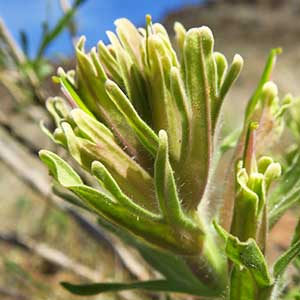Castilleja xanthotricha
Castilleja septentrionalis
John Day or yellow-hairy paintbrush, John Day paintbrush, yellow hair paintbrush, yellow-hair Indian paintbrush
Labrador Indian paintbrush, northeastern paintbrush, northern or sulfur or yellow paintbrush, northern paintbrush, northern painted-cup, sulphur Indian paintbrush, sulphur paintbrush
few to several, ± decumbent to erect or ascending, unbranched, sometimes with short, leafy axillary shoots, hairs erect to spreading, long, soft, eglandular, mixed with short stipitate-glandular ones.
few to several, erect to ascending or ± decumbent at base, unbranched or branched, sometimes with short, leafy axillary shoots, glabrous or glabrate proximally, sometimes hairy, hairs spreading to retrorsely curved, short, ± stiff throughout, spreading, longer, soft to ± stiff distally, often glandular and short-glandular.
green, linear, lanceolate to broadly lanceolate, oblong, or cuneate, 0.8–5 cm, not fleshy, margins plane to wavy, involute, 0–5-lobed, apex acute, sometimes rounded;
lobes spreading, linear, arising below mid length, nearly as broad as center lobe, apex acute.
green to purplish, linear-lanceolate or narrowly to broadly lanceolate, 2–7(–8) cm, not fleshy, margins plane, flat to involute, prominently veined, 0(–3)-lobed, apex acute to acuminate;
lobes ascending, linear to narrowly lanceolate, short, apex acute or obtuse.
3–14 × 1.5–4.5 cm;
bracts proximally greenish, rarely dull reddish purple, distally white to cream, rarely pale yellow or dull, pale pink (sharply differentiated from proximal coloration), lanceolate or oblong to narrowly ovate, (3–)5–7-lobed;
lobes ascending, linear to obovate, ± broadened distally, medium, long, proximal lobes arising below mid length, central lobe apex broadly rounded to truncate, others acute to rounded.
2.1–11 × 1.5–4 cm;
bracts proximally greenish to pale yellow-green, sometimes brownish purple, distally white to cream or light yellow, sometimes light pink or buff, sometimes aging pink or reddish, broadly lanceolate to oblong or obovate, sometimes lanceolate, 0–3(–5)-lobed, sometimes with irregular teeth at apex;
lobes erect, triangular, short, arising at or above mid length, center lobe apex obtuse to rounded, sometimes acute, lateral ones acute.
curved, 17–23 mm;
tube 15–19 mm;
beak exserted, adaxially green, 5–8(–9) mm, puberulent, stipitate-glandular;
abaxial lip deep purple (color sometimes visible through calyx), green, pinkish, or pale yellow, ± prominent, slightly inflated, usually hidden in calyx, sometimes right at top of calyx, 2 mm, ca. 50% as long as beak;
teeth ascending, whitish, yellowish, pink, or green, 1–1.5 mm.
± straight, (16–)18–30 mm;
tube 10–20 mm;
teeth of abaxial lip rarely exserted, beak exserted;
beak adaxially green or yellowish, 6–12 mm;
abaxial lip green or whitish, reduced, slightly inflated, 1.5–3 mm, 25–30% as long as beak;
teeth incurved to erect, green or white, 0.5–2 mm.
colored as bracts, 15–26 mm;
abaxial and adaxial clefts 3.5–7 mm, 25–50% of calyx length, deeper than laterals, lateral 2–5 mm, 12–25% of calyx length;
lobes linear, oblong, or narrowly triangular, center lobe apex usually rounded, lobes acute to rounded.
colored as bracts, 13–23(–28) mm;
abaxial clefts (6–)8–13 mm, adaxial (5–)6–10(–11) mm, clefts (25–)35–50% of calyx length, deeper than laterals, lateral 1–4 mm, 5–25% of calyx length;
lobes triangular to lanceolate, abaxial and adaxial segments often differing in length or width, apex obtuse to acute.
= 48.
= 24, 48, 96.
Castilleja xanthotricha
Castilleja septentrionalis
Castilleja xanthotricha is endemic to moderate elevations in the sagebrush hills of the John Day River drainage in north-central Oregon. N. H. Holmgren (1971) hypothesized that this tetraploid species is of allopolyploid hybrid origin between C. glandulifera and C. oresbia.
(Discussion copyrighted by Flora of North America; reprinted with permission.)
Castilleja septentrionalis is one of the most widespread species in the flora area. It occurs throughout much of the Rocky Mountain region, from New Mexico northward into southern Canada and sporadically eastward to the Atlantic coast, as well as in the higher mountains and notches of New England. Rocky Mountain plants are commonly called C. sulphurea, but there is broad morphological overlap between these plants and those in New England and eastern Canada, where C. septentrionalis was first described, and they are here considered synonymous. Varietal segregates may eventually prove to be appropriate, especially in the Canadian Rocky Mountains and in southeastern Canada and the adjacent United States, but this should await a comprehensive and detailed review across the full range of the species.
The relationship of Castilleja septentrionalis with the largely alpine species, C. occidentalis, has been the subject of much discussion, but the two have discrete ranges and usually remain reasonably easy to separate. The same cannot be said for plants from the Canadian Rocky Mountains, where some specimens in relatively low-elevation, riverine flood plains and lake basins seem transitional to the boreal-arctic C. pallida.
Castilleja septentrionalis occasionally forms localized hybrid swarms with its close relatives, C. miniata and C. rhexiifolia, where the morphological boundaries between the species seem to disintegrate. However, most populations of all three species are distinct and easily recognizable, and each has a different range, despite extensive sympatry. A possible hybrid with C. linariifolia bears the name C. ×cognata Greene, and a probable hybrid with C. miniata from southern Nevada is known as C. ×porterae Cockerell.
(Discussion copyrighted by Flora of North America; reprinted with permission.)
